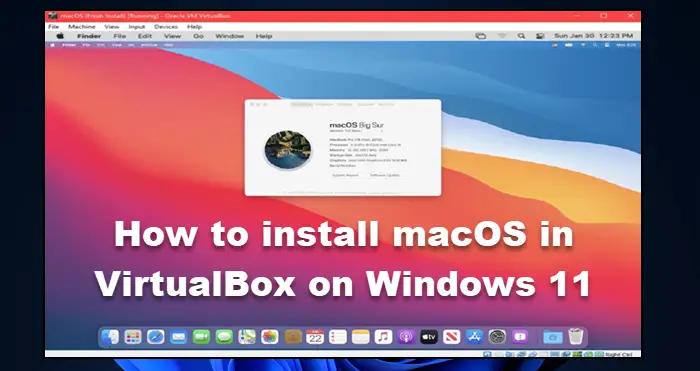Can I run macOS on Windows 11?
In order to run macOS on Windows 11, we will use Oracle VirtualBox. However, you need to make sure that you have a legally obtained copy of macOS, 2GBs of memory, and a 64-bit computer with 4 logical CPUs, and you should be an administrator or have administrative privileges. If you have all this, go ahead and install macOS on your Windows system.
Install macOS in VirtualBox on Windows 11
Installing macOS in VirtualBox on Windows 11 is the following four-step process. Let us talk about them in detail.
1] Download macOS File
You need to download the macOS file from Apple Store. You need to download the macOS BugSur file from the Store, since it is a large file, you need a good enough Internet connection, an ample amount of space, and some time. Keep in mind, downloading a file from an unauthorized place is not recommended.
2] Install VirtualBox
Once you have downloaded the operating system, go ahead and download VirtualBox, the Virtual Machine software we will be using. To do the same, go to download.virtualbox.org and select VirtualBox-6.1.26-145957-Win.exe. You need to download the extension package called Oracle_VM_VirtualBox_Extension_Pack-6.1.26-145957.vbox-extpack alongside the VirtualBox software.
After downloading both files, go to the Download folder, and run VirtualBox-6.1.26-145957-Win.exe which is the installation package. You then have to follow the on-screen instructions to install the VM, once it is installed, run the extension package and install it as well. Note: In case, you get an error when installing either of the apps, just disable Memory Integrity, reboot your computer, and then run the installation media.
3] Create the Virtual Machine
In order to install macOS, we first need to create a virtual machine using Oracle VirtualBox. The process may seem a bit intimidating, but if you follow the steps mentioned below, you will be able to create a VM without any hassle. To do the same, just follow the prescribed steps. This way, our Virtual Machine is created.
5] Configure VM’s Settings
Once you have created the Virtual Machine, let us configure its settings to make it suitable for macOS. To do the same, first, we are going to make some changes in the VM that we created and then run some CMD commands, so, follow the prescribed steps to do the former. The job is not done yet, we need to run some commands before installing macOS. Before doing the same, close VirtualBox, not just by clicking on the Cross button but also by opening VirtualBox, right-clicking on the running program, and selecting End Task. Now, go to gist.github.com and copy all the codes into a Notepad file. In the first line of the copied code, you need to enter the location where you have installed VirtualBox, by default, the location will be the following, but if you have done a custom installation, use a different location. After editing the location, change every instance of Your Virtual Machine Name to macOS. After making all the adjustments, the code will look something like the following. Note: Except for the address in the first line, everything else must be the same in your code as well. However, if you have not changed the location during the installation process of VirtualBox, even the address will be the same. To run these commands, open Command Prompt as an administrator and execute every single line separately. Running the first line will redirect you to the VirtualBox directory, and the rest of the code is there to make the VM suitable for macOS.
6] Install macOS in VirtualBox
After doing all the aforementioned steps, the environment to install macOS is created, all we have to do now is run the Virtual Machine and install the OS. Follow the prescribed steps to install macOS in VirtualBox. That’s how you can install a macOS Big Sur on a Windows computer using VirtualBox. Also Read: How to install Microsoft Access on Mac
How do I install macOS on VirtualBox?
Installing macOS on VirtualBox is a five-step process, you first need to have both macOS and VirtualBox, then create VM, make it suitable for macOS and then install the OS. If you want to carry on with the installation, check out the aforementioned guide. Hopefully, you will be able to install macOS easily. Read: Best free Mac emulators for Windows.

